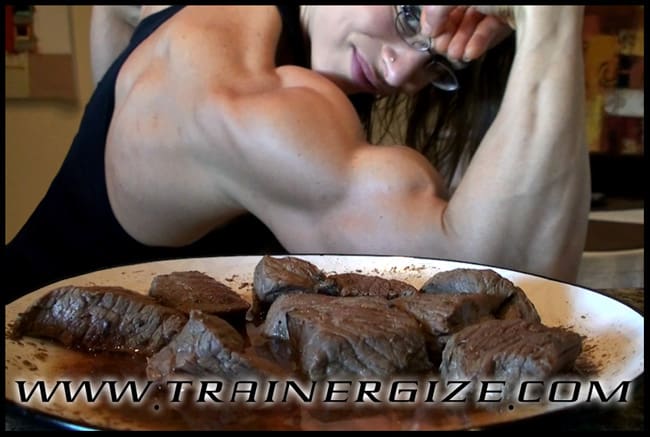“Injuries are not caused by methods per se, but by the inappropriate, premature, and/or excessive application of methods.”
– Charles Staley
In all the years I’ve been involved in sports conditioning, I’ve never seen an issue with as much longevity and potential for heated debate as the question of whether or not it is necessary, safe, and or effective to perform “explosive” or “ballistic” movements in the weight room.
If you’re active on the internet, you’ll discover endless, passionate (and often, ugly) confrontations between those who advocate slow lifting speeds, and those who espouse so-called explosive training techniques, such as Olympic lifting and it’s derivatives, and plyometric training methods.
While it is true that explosively-performed (i.e., high velocity) repetitions can be potentially more dangerous than low velocity movements, it’s just as true that heavier weights, since they put more tension on the musculoskeletal system, are potentially more dangerous than lighter weights. So it really becomes an issue of using the right tool for the right job.
Remember, in order to train a biologic system, you must apply stress to that system. Too much stress leads to injury; too little leads to little or no effect; just the right amount leads to a training effect.
As you read this article, please refer to the section below which outlines the more technical terms used herein. These terms are often used inappropriately, which leads to even more confusion.
Also, please resist the human instinct to either agree or disagree with the statements I will make. Instead, simply listen. Observe. Correlate the material to your own experiences. In this way, you’ll give yourself the best opportunity to come to an intelligent decision regarding this issue.
What is Training?
Training involves the exposure of a biologic system to the systematic application of increasing stress at a frequency, intensity, and duration below that system’s maximal tolerance limit, which, over time, causes a resultant increase in that system’s tolerance limit (1).
Different training methods cause different adaptations. For example, sets lasting between 20 and 70 seconds seem to promote hypertrophy better than sets of greater or lesser duration (2). Sets performed with incomplete rests develop anaerobic capacity through a greater proliferation of capillaries in the muscle(s) being trained (3). High repetition sets develop Type I (slow twitch) fibers, while low repetition sets with heavy weight challenge Type II (fast twitch) fibers.
Long-term performance of an exercise which takes a muscle through less than it’s full range of motion promotes a shortening of that muscle, while chronic use of exercises which take the muscle through it’s full range of motion encourage the muscle to become longer (4).
These examples of the specificity principle strongly imply that the neuromuscular and musculoskeletal systems are capable of adapting to explosive movements just as they are capable of adapting to any other type of stimuli provided.
This is the real key to understanding this issue…that the athlete moves through an appropriate series of progressions which allow a sequential exposure to a gradually increasing stimulus. If you skip any part of this progression, or if you progress too quickly, injury may result as you exceed the body’s “maximum tolerance threshold” to that stimulus.
Defining the Issue
Before we proceed further, please appreciate that this issue is a difficult one to analyze, since there are several ways to lift a weight.
For example, powerlifting is not normally considered an “explosive” event, since at 1RM levels, the bar moves very slowly, due to its mass. Nevertheless, the lifter is attempting to maximally accelerate the bar. So, are we discussing the actual speed of the lift, or the attempt to maximally accelerate the weight (even if the implement speed is low to to its mass)?
Also, we must distinguish between lifting weights at a fast tempo, and lifting weights in an accelerative manner (increasing the speed over the duration of a repetition). Further, are we speaking of lifting light to moderate weight, or heavy weights?
For instance, when performing the deadlift, using a fast lifting speed with a light weight would simply reduce both the tension, as well as the time under tension, of the involved musculature, leading to a compromised training effect.
However, when deadlifting a challenging weight, you stand a better chance of making the lift if you attempt to accelerate the bar. It is important to understand that this is a smooth acceleration, not a rapid “jerk” on the bar, which would in fact, increase the likelihood of injury.
Incidentally, I define “good form” a bit differently than most. If you enter a workout with pre-determined parameters such as number of sets and reps, tempo, optimal body alignment, range of motion (which may be complete or partial) length of rest periods, and you maintain these parameters, you’re using “good form.”
So for example, you may set out to use a 2 second tempo, which is relatively fast (and may or may not be safe, depending on the exercise, your experience, the weights being lifted, and a host of other factors). However, if you set out to do a 4 second tempo, and due to fatigue or inattention it ends up being a 2 second tempo, this shows a lack of control, which in my opinion, heightens the potential for injury.
So, although many people cite the dangers of “fast” or “explosive” lifting, I hope you can now appreciate that the issue is far more complex than most people consider. During this article, I will make reference to explosive, ballistic, and accelerative lifting techniques, in an effort to cover the various possible methods.
Is Accelerative Activity an Inherent Characteristic of Human Movement?
The phenomenon known as the stretch-shortening cycle (or SSC) strongly hints that the body is, in fact, designed for ballistic and accelerative stress (5).
To illustrate this concept, I’ll ask you to imagine the act of throwing a baseball, overhand style.You grab the ball, extend your throwing arm behind you, and, just as the arm nears complete extension (the eccentric portion of the throw), you rapidly reverse the motion (the concentric phase) and release the ball.
Now, just as an experiment, extend the arm back, and pause for three seconds before you throw. It’s intuitively obvious that the second throw, aside from feeling totally unnatural, will travel much slower and result in a shorter throw.
When you throw (or jump, hit, etc) correctly, the musculo-tendinous unit stores potential kinetic energy during the eccentric phase of the movement. At full stretch, the muscle begins its reversal into the concentric phase. If you use proper timing (the “switch” between eccentric and concentric must be very rapid), you can recover all that potential energy and return it during the concentric phase. If you wait-even for a split second- the energy will dissipate.
A simpler way to visualize the SSC is to imagine the muscles as elastic bands that stretch during eccentric activity, and contract during the concentric portion of the movement. (Incidentally, plyometric training programs, usually consisting of various jumps and throws, are designed to train the elastic potential of the musculoskeletal system.)
If you watch people carefully in various situations, you’ll notice that, whenever there is an option to accelerate a load, people will take that option.
On stairclimbing machines, people will, especially as fatigue sets in, tend to step in a bouncy, choppy manner. When a heavy box must be lifted from the floor to a high shelf, a person will accelerate the box throughout the lift.
Further, the motor cortex will normally choose a movement pattern where more muscle groups can participate in the effort, in order to conserve energy and avoid dangerous levels of stress to any single muscle involved in the movement.
Optimal Progression Ensures Safety
Now the question becomes “If this is how muscles work in everyday activities, should we train muscles this way?” My colleague Paul Chek often asserts that “First isolate, then integrate.” What Paul means by this is that before asking the chain to produce high levels of force, one should first strengthen each link of the chain, especially the weakest links.
When training a link, you must “isolate” that link…in other words, create a movement or exercise where associated links have no ability to assist in that movement.
Since muscles are the links in any kinetic chain, another way to view this progression is to “First, train muscles, then train movements.” Either way you choose to conceptualize it, most accelerative lifting movements (such as modified Olympic lifts such as power cleans & snatches, push-jerks, jumps, throws, etc.) involve large numbers of muscles.
Therefore, if these individual muscles are brought to maximum strength levels prior to accelerative, multi-joint movements, the athlete lessens the potential for injury. However, if any link in the chain is relatively weak, that link would logically have a greater potential for injury during any explosive type exercise that involves it.
As an example of the proceeding progression, an athlete wishing to perform power cleans might spend 6-9 weeks developing strength in the quads, hamstrings, spinal erectors, trapezius, glutes, scapular retractors, and gastrocs, and then gradually switch to more explosive training methods, while maintaining the strength of the individual muscle groups, using a reduced volume (about 30 to 50 percent) of work.
In my experience working with Olympic weightlifters, I have used various permutations of this progression and have never witnessed a serious injury.
A recent study by Brian P. Hamill (please see sidebar entitled Multi-Sport Comparative Injury Rates) collaborates my observations (6). In his analysis of statistics derived from surveys and competitions, Hamill found that competitive weightlifting is safer than many other sports, including soccer, recreational weight training, and (believe it or not) badminton.
In his analysis, Hamill suggests that qualified supervision is the most important precondition for safe participation in both competitive weightlifting and recreational weight training.
Should Bodybuilders Perform Ballistic, Explosive, or Accelerative Weight Training?
Legions of successful competitive bodybuilders have achieved their goals without using these techniques. However, it has been my experience that many top physique stars have achieved their success in spite of their training methods and habits, not because of them.
When you have a superior somatype and a favorable hormonal system to support it, and when you have a superior ability to train hard on a consistent basis, you don’t need to sweat the details. Recreational pharmacology should be factored in, also.
But let’s assume that you’re at least the fourth generation of your family to stand upright. Let’s also assume you have a job, and limited chemistry skills. Let’s further assume that your training program could benefit from a bit of variation, and even some fun.
If you fit this profile, and if you employ qualified supervision (I’d recommend calling the United States Weightlifting Federation at 719-578-4508 in order to find a qualified weightlifting coach in your area), I would urge you to explore these methods.
The downside? For starters, HIT Jedis will call you a fool. Also, you may abandon bodybuilding for the sport of Olympic weightlifting. You also run the risk of slow twitch fiber atrophy, as your Type II fibers hypertrophy to unprecedented size. Finally, you may suffer guilt pangs as you find yourself actually enjoying training again. On balance, I’d say it’s worth the risk.
SIDEBAR – Is “HIT” Dead?
For years, the most vocal faction of coaches and athletes in opposition to explosive lifting techniques has been known as “HIT” an acronym meaning “High Intensity Training.”
The HIT doctrine took root through the teachings of Arthur Jones, and has been furthered by Mike Mentzer, and several collegiate strength coaches. HIT has traditionally favored single set, low-speed, machine based movements, and has been vehemently opposed to multi-set periodized approaches, explosive lifts and plyometrics, and free weight exercises.
Recently, however, the HIT “Jedi” (the self-appointed term for adherents of the HIT philosophy) have all but merged with the mainstream on issues of number of sets, repetition ranges, and the use of free weights. They remain steadfast on the use of explosive lifting techniques, however.
In the recently released HITFAQv2.0a , the section describing “proper form” advises “raising and lowering the weight in a deliberate, controlled manner.” The FAQ continues “Anytime, anyone, be they Mr. Universe, or whomever, tells you to move a weight fast, in an ‘explosive’ style, just walk away. That person is a fool.” (I always thought that anyone who took comfort in applying blanket statements to a wide range of circumstances was a fool, but maybe I’ve got it wrong!)
Important Terminology
1) Torque:
The effectiveness of a force to produce rotation of an object about an axis (7). Measured as the product of force and the perpendicular distance from the line of action of the force to the axis of rotation. The SI (International System) unit of torque is the newton-meter (N.m)
2) Force:
That which changes or tends to change the state of rest or motion in matter (7). Force may increase or decrease the velocity of an object. The SI unit of force is the newton (N).
3) Work:
Tthe product of an expressed force and the distance of displacement of an object, irrespective of time (7). The SI unit of work is the joule (J). To measure work, you would multiply the force applied by the distance the force was applied over.
4) Power:
The rate of performing work (7). The SI unit of power is the watt (W). To measure power, you would
5) Velocity:
A change in either the speed or direction of an object, or a change in both the speed and direction of an object (8). Most people use the term velocity to describe a change in the speed of an object.
6) Explosive Strength:
One of two elements of speed strength (power) -the ability to apply a maximal force against an external object (such as a shot put or barbell), or ones own body, as in sprinting or jumping, in minimum time (9).
7) Ballistic:
Infers movement which is accelerative, of high velocity, and with actual projection into free space (10). Ballistic activities include throwing and jumping.
Multi-Sport Comparative Injury Rates
Sport Injuries (per 100 participation hours)
Schoolchild soccer 6.20
UK Rugby 1.92
South African Rugby 0.70
UK Basketball 1.03
USA Basketball 0.03
USA Athletics (Track) 0.57
UK Athletics 0.26
UK Cross-country 0.37
USA Cross-country 0.00
Fives 0.21
P.E. 0.18
Squash 0.10
USA Football 0.10
Badminton 0.05
USA Gymnastics 0.044
UK Tennis 0.07
USA Powerlifting 0.0027
USA Tennis 0.001
Rackets 0.03
USA Volleyball 0.0013
Weight Training 0.0035 (85,733 hrs)
Weightlifting 0.0017 (165,551 hrs)
References:
1) Gross, J., Fetto, J., & Rosen, E, . Musculoskeletal Examination, 1996. Cambridge, Blackwell Science, p.p.5.
2) Poliquin, C., The Poliquin Principles, 1997, Napa, Dayton Publisher’s Group, p.p. 24
3) Fleck, S.J., & Kraemer, W.J., Designing Resistance Training Programs, 1987, Champaign, Human Kinetics, p.p. 58.
4) Komi, P.V (Ed.), Strength and Power in Sport (1992). London. p.p.29
5) Komi, P.V (Ed.), Strength and Power in Sport (1992). London. p.p.169
6) Hamill, B.P., Relative safety of weightlifting and weight training. J. Strength and Cond. Res. 8(1);53-57.1994.
7) Knuttgen, H.G., Force, Work, and Power in Athletic Training. Sports Science Exchange. 8(4). 1995.
8) Norkin, C.C., & Levangie, P.K. Joint Structure & Function. F.A. Davis Company (1992), Philadelphia. p.p.17.
9) Kurz, T. Science of Sports Training. Stadion (1991), Island Pond. p.p. 85
10). Kraemer, W.J. & Newton, R.U., Muscle Power. Muscular Development. March, 1995, p.p. 130-131.







Great article Charles. For me, the money shot statement was:
“…it has been my experience that many top physique stars have achieved their success in spite of their training methods and habits, not because of them.”
Can’t tell you how many times I have made that exact statement. 99 out of 100 times, the worst person to ask advice from is the biggest guy in your gym.
Personally, I have been putting more focus into the “functional” areas of training, and it has only improved my strength and bodycomp.
My O lifts still suck however…..
Thanks Will…
We’ve just actually put the finishing touches on a one-day Olympic weightlifting clinic designed to get “average” people very competent in the lifts in a single session. Here’s some verbiage from the brochure:
What Makes This Seminar Unique?
Many weightlifting coaches “shoot themselves in the foot” with their efforts to validate the sport by emphasizing the amount of time and effort it takes to master the athletic intricacies necessary to compete at a high level. The end result is that the prospective athlete becomes turned off, assuming that the “Olympic lifts” are too difficult for the average person to learn in a reasonable amount of time.
Charles Staley’s approach to learning “the lifts” is both unique and refreshing: After a brief demonstration, attendees start by learning rough approximations of the snatch, clean, and jerk, with minimal initial correction. This allows the participant to immediately experience the uniquely satisfying sense of “completion” one feels when racking the bar on the shoulders or fixing it overhead in the snatch or jerk.
Next Charles quickly begins refining the student’s movement patterns through a series of unique analogies, observations, games, and demonstrations. As each student begins to improve, no breakthrough— minor as it may be— goes unnoticed by Charles. Quickly and palpably, each attendee gains confidence and precision as they progress from drill to drill. Ear-to-ear grins are not uncommon as students accomplish the unexpected: Olympic lifting competency in one day.
Sounds like a seminar I, and many others, could benefit from to be sure!
Hi, I’m new to Fat Loss Revealed, and will says to say hi on the blogs, so I thought I would ask a question.
“full range of motion promotes a shortening of that muscle, while chronic use of exercises which take the muscle through it’s full range of motion encourage the muscle to become longer”
I thought muscles could not be made shorter or longer? that there are set insertion points for those muscles? (i’m no biologist =)
I also thought, If you are talking about flexibility – then isn’t a dedicated stretching program more necessary than “what weight lifting program” you are doing?
Since the goal of weight training is strength and/or building lean body mass.
I’m just confused by this part….
The parts about strengthening the individual parts in the chain to make the whole chain strong make sense and I understand.
Sincerely, George.
Hi George and GREAT question that will present me with a challenge to adequately answer it!
Imagine that you’re a bodybuilder obsessed with having huge biceps. Over time, you realize that you can curl heavier weights if you use partial range of motion as opposed to full ROM. So you do all your curls w/o fully extending your elbows at the completion of each eccentric phase.
Over time, this ill-advised tactic can cause “contracture,” or a chronically shortened muscle that can have negative consequences on posture and overall functionality.
But what does contracture really mean?
Although it would seem that the bicep’s origin and insertion points are “fixed,” they really aren’t. Have a look at this illustration:
http://hippie.nu/~unicorn/tut/img/basics/humananatomy/biceps.jpeg
You should be able to notice that the distal attachment is not in/on the elbow per se, but actually significantly lower than the elbow. If you’ve got a chronically shortened bicep, you’ll be walking around the slightly flexed elbows, which means that the bicep’s two attachments points are indeed closer.
Does that help?
Your blog site is great. Give thanks you so much for delivering a whole lot of interesting facts and techniques. Most definitely i’ll bookmark your blog website and will be most definitely coming back. All over again, I recognise the value of your work and furthermore supplying a huge amount of essential information and facts for the followers.
I do accept as true with all of the concepts you’ve offered in your post. They’re very convincing and can definitely work. Nonetheless, the posts are very short for newbies. May you please extend them a bit from next time? Thank you for the post.
One of the best articles on the topic I have ever read, so good thing it’s on the BrinkZone!